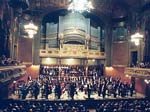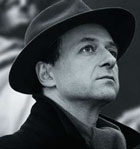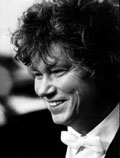|
|
|
[INDEX]
|
Carnegie Hall: Budapest Festival
Orchestra and Hungarian National Philharmonic Orchestra
By Philip Anson / January 16, 2003
On the Aisle |  |
 The
Budapest Festival Orchestra (photo left) was founded by Hungarian conductor
Ivan Fischer and pianist Zoltan Kocsis in 1983 but did not start playing
together permanently until 1992. Created as an alternative to what was
then perceived as mediocre “official” socialist-era Hungarian orchestras
such as the Hungarian National Philharmonic Orchestra, the Budapest Festival
Orchestra hired musicians on merit and asked them to work for little or
nothing while the band established itself and sought private funding.
The group toured to raise its profile and landed a contract with Philips
Classics. Its albums of music by Liszt, Dvorak, and Bartok got good reviews. The
Budapest Festival Orchestra (photo left) was founded by Hungarian conductor
Ivan Fischer and pianist Zoltan Kocsis in 1983 but did not start playing
together permanently until 1992. Created as an alternative to what was
then perceived as mediocre “official” socialist-era Hungarian orchestras
such as the Hungarian National Philharmonic Orchestra, the Budapest Festival
Orchestra hired musicians on merit and asked them to work for little or
nothing while the band established itself and sought private funding.
The group toured to raise its profile and landed a contract with Philips
Classics. Its albums of music by Liszt, Dvorak, and Bartok got good reviews.
Yet the road to success was rocky. Fischer faced unexpected competition
from his former partner Kocsis who in 1997 became the artistic director
of the Hungarian National Philharmonic Orchestra. Kocsis more or less
undercut Fischer by implementing his reforms at the National and landing
several millions of dollars in government funding. Meanwhile, Fischer
was left to beg for corporate handouts to support his fledgling “capitalist”
enterprise. Today the Budapest Festival Orchestra is actively trying to
brand itself and to find a niche in the competitive world of major symphony
orchestras.Its job is not made any easier by the simultaneous U.S. touring
of its erstwhile competitor the Hungarian National Philharmonic Orchestra.
 The
Budapest Festival Orchestra's two Carnegie Hall concerts were well attended,
with local Hungarians much in evidence. Alas, both concerts were spoiled
for me by massive doses of orchestral music by Hungarian composer Franz
Liszt. Liszt has been falling out of fashion for a century. His inflated
orchestration and one-dimensional program music has been shown up by the
revolutionary innovations of Wagner, Berlioz, Mussorgsky and Debussy. The
Budapest Festival Orchestra's two Carnegie Hall concerts were well attended,
with local Hungarians much in evidence. Alas, both concerts were spoiled
for me by massive doses of orchestral music by Hungarian composer Franz
Liszt. Liszt has been falling out of fashion for a century. His inflated
orchestration and one-dimensional program music has been shown up by the
revolutionary innovations of Wagner, Berlioz, Mussorgsky and Debussy.
The Jan. 15 concert opened with the slim, forgettable symphonic poem Tasso:
lamento e trionfo, S. 96. Then came Liszt’s Totentanz for Piano and Orchestra,
S. 126, a turgidly overwritten riff on the Dies Irae plainchant. This
piano concerto was bravely defended by the accomplished French pianist
Jean-Yves Thibaudet, who played the hysterically busy keyboard part flawlessly
from memory. Though the Totentanz is a meretricious showpiece, it at least
offered some moments of technical vistuosity and high camp thanks to the
leather-jacketted Thibaudet, who also offered the Debussy Etude Pour les
Arpčges as an encore.
The hour-long Faust Symphony lay like a tombstone over the Jan. 16 concert.
Despite some pretty melodies and catchy rhythms, it dragged unconscionably
(the Washington Post, reviewing one of the orchestra’s later concerts,
called the Faust Symphony “a perfect example of a composer faking a masterpiece”).
In the Gretchen movement a viola was briefly off pitch. But the horns
were better here than in the Wagner.
The Jan. 16 concert opened with Wagner’s Die Meistersinger Overture. The
playing was not particularly refined, with loud , pitch-shy horns and
a squeek in the wind section. The extended contrapuntal wind playing barely
held together. The Prelude and Liebestod from Tristan und Isolde which
followed was ragged and suggested Fischer (photo left) has problems getting
a handle on Wagner and/or his band. The orchestra’s traversal of Richard
Strauss’s Also sprach Zarathustra was correct and professional, but lacked
the rhythmic rigor, tonal finesse and architectural development one has
come to expect from top ensembles like the Berlin Phil and the Vienna
Phil.
Overall, the Budapest Festival Orchestra has the elements of a world-class
band, but those disparate parts have not yet coalesced. Their current
method is to tackle big works like a linebacker tackles his opponents,
with a wild aggression that precludes such niceties as tonal purity and
convincingly thought-out interpretation. The orchestra did not sound as
smooth and impressive live as it does on its recordings. It is a band
that still seems to be in search of a style and an identity.
 The
Hungarian National Philharmonic Orchestra under Zoltan Kocsis (photo lower
left) performed at Lincoln Center barely a fortnight after Fischer's orchestra
hit Carnegie Hall. The National has a reputation for being a technicaly
insecure bunch of routiniers, but their playing was surprisingly enjoyable.
Like the Budapest Festival Orchestra, they programmed lots of Liszt, but
unlike the Budapest's choices, the National's Liszt was exciting fare,
played with brio. Les Préludes offered varied visions of Wagnerian
pastoral, spiced by resinous oboe and woody clarinet. The Piano Concerto
No. 1 in E-flat major, ineptly conducted by Kocsis as he played the Steinway,
may not have been homogenous high art, but it had thrills aplenty. The
Hungarian National Philharmonic Orchestra under Zoltan Kocsis (photo lower
left) performed at Lincoln Center barely a fortnight after Fischer's orchestra
hit Carnegie Hall. The National has a reputation for being a technicaly
insecure bunch of routiniers, but their playing was surprisingly enjoyable.
Like the Budapest Festival Orchestra, they programmed lots of Liszt, but
unlike the Budapest's choices, the National's Liszt was exciting fare,
played with brio. Les Préludes offered varied visions of Wagnerian
pastoral, spiced by resinous oboe and woody clarinet. The Piano Concerto
No. 1 in E-flat major, ineptly conducted by Kocsis as he played the Steinway,
may not have been homogenous high art, but it had thrills aplenty.
Kocsis is a remarkable pianist and his fingerwork is enthralling, for
all its heart-on-sleeve emotion.Some people complained that the orchestra's
instruments sounded cheap, and that Kocsis was conducting out of vanity.
True, after the intermission Bartok's Dance Suite and Kodaly's Hary Janos
Suite were sloppy and undramatic. But for me, there was a gutsiness and
confidence in the Liszt, at least, that had the ring of authenticity and
which provided both entertainment and catharsis.
.
> Carnegie Hall
> Budapest Festival Orchestra Web site
[INDEX]

|
|
|


